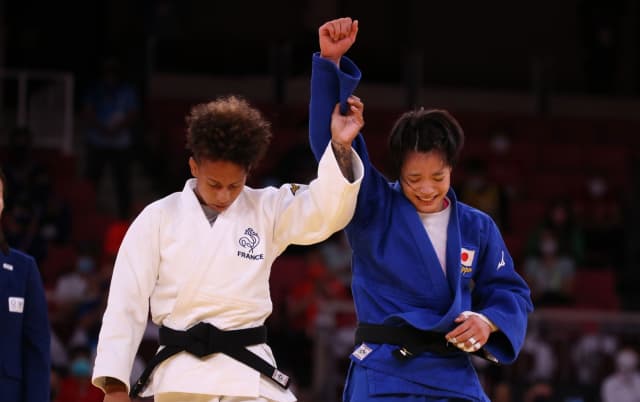This match, which concluded in an epic golden score period, saw Abe Uta explode with emotions and the two protagonists fell into each other's arms for long seconds once the young Japanese girl was crowned. It is the visible result of years of preperation.
As we have said, the double world champion, Abe Uta, was the athlete to beat to prevent her from climbing to the top of Olympus. In front of her stood the French judoka Amandine Buchard, who has not had much luck with the Olympic Games so far. In 2016, following recurring weight concerns, she decided to go up to -52kg which deprived her de facto of her qualification for the Rio 2016 Games. As Amandine said then, she had fallen, she had to raise again. Here in Tokyo, she has done it in the most beautiful way.
Until recently, Amandine occupied the first place in the world rankings, but just before the last World Championships in Hungary the situation changed slightly, but this is anecdotal. In Tokyo 2020, was the French not also the number one seed?
This world ranking proves that five years ago Buchard made the right decision. Okay, she was depriving herself of the Games in Rio, but she was opening the doors to Japan. She just had to be patient, which she was. Tournament after tournament, training camp after training session, she was accumulating experience and results. She was honing her ability to take on the best and sharpening her weapons to beat Abe Uta, which she did at the Osaka Grand Slam, but that was in November 2019.
If we look back on the final of the Tokyo 2020 Games, we discovere an Amandine Buchard who came to win and who did everything for it. She had a plan and she implemented it to the letter. The strategy was clear and recalled by Amandine's coach on the chair, "Amandine! Right arm, concentrate on the right arm."
Another interesting element concerns the special technique of the Frenchwoman, her kata-guruma, which allowed her to win quickly in the preliminary rounds. In the final, she knew that facing Abe Uta it might be another story, with the Japanese being perfectly prepared to counter Buchard. Yet she continued to attack with her special technique, making sure to double or triple her attacks, so as not to risk the false attack. Again, the coach on the chair repeated it to her throughout the final.
But as Abe Uta was penalised and the planets seemed to align for Buchard, what made the difference? Without doubt, a sequence repeated thousands of times in training. Throughout the final, several times, the two champions found themselves on the ground and each time Abe Uta tried to apply a specific technique. Buchard was conditioned, until her opponent changed direction and applied another choice.
This ability to condition an athlete to face a specific opponent is prepared for years, through training and preparation competitions. Both the French and the Japanese have had years to be ready for D-Day and they were, in the most beautiful way. Eventually everything was decided on a change of direction, on a secret weapon, prepared in the confines of a Japanese dojo.
One emerged victorious and, with her brother, inscribed her name in the pantheon of international sport. The other did not win the gold but she won the respect of her peers. As Amandine Buchard said a few minutes after Abe's victory, "This is not the last time we will meet in the final." We can be sure of that, and we can also be sure that the show will still be there. This is the judo we love.


